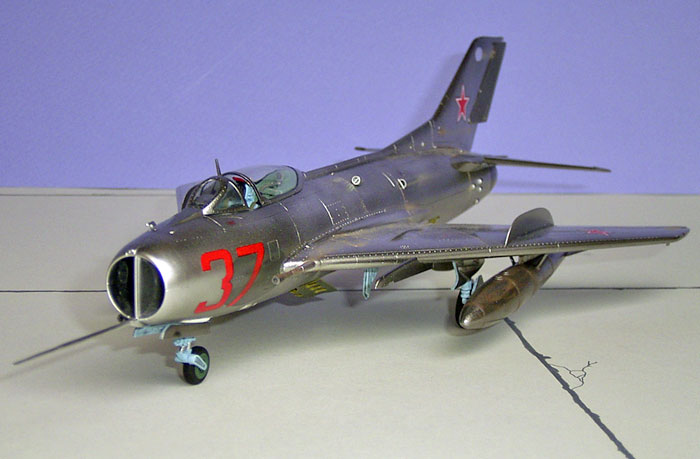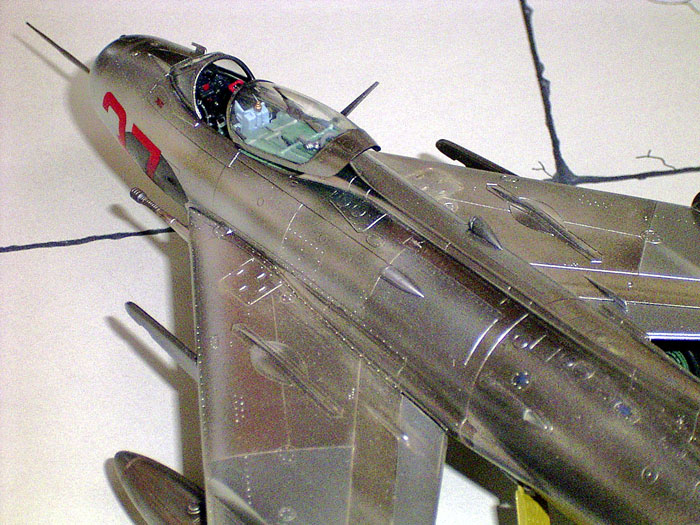|
Trumpeter's
1/48 scale
MiG-19S Farmer C
by Ingo Degenhardt
 |
|
MiG-19S Farmer C |
images
by Lutz Degenhardt

HyperScale is proudly supported by Squadron
The MiG-19 was the first
Soviet-produced fighter plane capable of reaching supersonic speeds in
level flight. The first production aircraft were already delivered in
1955, but showed several problems; the most significant being poor
control effectiveness at high speeds. Primarily this was cured by
inventing an all-flying horizontal tail. Hence the suffix “S” (stabilizator)
This version became operational
in mid-1956. Soviet production of the MiG-19 in all variants was
comparatively small, slightly exceeding 2000 aircraft, and ended in
1958.
The majority of this aircraft
was build under license in Shenyang, China as the Shenyang F-6 with a
production of approximately 4000 aircraft to serve with the Chinese Air
Force and Navy; but also for world-wide export.
This model was build completely
out of the box starting with the cockpit as usual. This is nicely
detailed with a clear-film insert for all the different gauges on the
instrument panel. Gunsight and Sidewalls are also well detailed. Only
seat belts from lead foil were added to the ejection seat..
The fuselage consists of seven
major parts even without the vertical fin which is attached separately.
The fuselage halves fit together very well but the various insert panels
(to be changed for different versions) and the nosecone need some work –
dry fitting, filling and sanding.

The completed wings with their
separately moulded flaps and ailerons in the chosen position are glued
into slots on the fuselage sides. This works quite well – with some
attention paid to their slightly drooped angle to be equal. Only a
little filling was necessary on the underside of the wing/fuselage
joint.
While I attached the flaps and
ailerons in their “up” position, the tailplane has the stabilators
glued on trailing edge down and the rudder in deflection to the left.
The speed brakes are also all in the open position.
All the small intakes on the
fuselage are separate parts with No. D48 being on of the smallest parts
I ever had to attach to an aircraft model.
In general, construction of the
MiG-19S is no problem if you keep an eye on all the seams found on the
fuselage.
As the
aircraft was to become an all natural metal plane, some extra care is
necessary to prepare it for painting. Polishing the bare plastic (Dremel
motor tool with polishing device) was the first. Next came a base coat
of Tamiya acrylic black – this revealed some flaws that were treated
with very fine wet&dry and afterwards the acrylic black was sprayed on
once more where needed. This created the correct base for the overall
coat of Alclad II’s Polished Aluminium. The model was held on a thin
wooden stick inserted through the air intake.
The different shaded panels on
the aircraft were sprayed with AlcladII Dark Aluminium while the exhaust
area and gun blast-shield were painted with Testor’s Metalizer
Magnesium. For masking I used Tamiya masking tape.
Two random panels received a
further base coat of gloss black enamel as base coat for AlcladII Chrome
– so resembling shiny brand-new replacement panels.

I do not know what happened, but
on the left upper wing the AlcladII crazed the surface in two or three
spots and no attempt to repair this was successful. So I finally had to
sand off the paint from all the upper left wing – down to the plastic
and then repeat the complete painting procedure.
A very strange incident – there
was definitively no enamel paint in the area, no grease or anything
else.
The cockpit colour is Xtracolor
X629 Blue/Green, wheel wells, gear struts and ejection seat were painted
in light blue (Humbrol) and for the wheel hubs I used X628 (Eastern
block wheel hub green)
Weathering
Contrary to most of my models
finished in natural metal this one received some noticeable weathering
made from flat black washes for the wheel wells, hubs and gear struts
while the surfaces were treated with pastel chalk powder of different
shades from sand colour to dark brown and near black. The most heavy
weathering was done to the wing tanks so these have a very ‘used’ look.
The Chrome-painted replacement panels support the overall effect of some
wear & tear.
Decals
Trumpeter gives the option of
three different aircraft here: Chinese F-6 (with a few construction
differences also), Russian Mig-19S and, also MiG-19S, an aircraft of the
former German Democratic Republic in a special Blue/Gold/Yellow colour
scheme with not further explanation regarding it’s purpose.
My choice was the soviet fighter
with bort Number Red 37.
The decals themselves are not of
a very good quality. As already experienced with Trumpeter’s Su-15TM,
some decals simply splinter into two or three pieces when dipped into
water. Furthermore they do not react with Superscale’s Set/Sol well
enough to blend into panel lines.

Fortunately there are not so
many decals on this model. The bort numbers and red stars were neatly
cut out with no carrier film left and received an overspray with
Testor’s Sealer for metalizer when they were all in their position on
the model and had thoroughly dried. For masking I used paint masks cut
from paper that were only a little taller than the decals themselves and
so the sealer serves to protect the decals and keep them from coming off
over the years.
Trumpeter’s decal placement
guide is unfortunately only very limited and there are several decals
where there is no information about their whereabouts.
The mentioned East German paint
scheme includes some markings not provided as decals which I consider
very hard to do by painting alone.
Furthermore a little information
about the chosen aircraft would have been nice (at least for the GDR-FarmerC,
as this one even includes some stencils in English!?)
Miscellaneous
I did not
dig in too deep about the MiG-19, so every mistake possibly found with
the Trumpeter MiG-19S is also found on my example.

I like to do this ‘simple’ kind
of modelling from time to time – no resin, no etched parts, very limited
research, no extra-decals, no AMS.
Sources
and Acknowledgements
|
Model and Text Copyright © 2004 by
Ingo Degenhardt
Images Copyright © 2004 by Lutz Degenhardt
Page Created 27 July, 2004
Last Updated
26 July, 2004
Back to
HyperScale Main Page
|
Home
| What's New |
Features |
Gallery |
Reviews |
Reference |
Forum |
Search